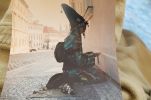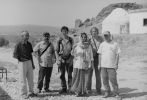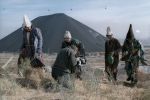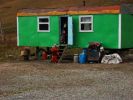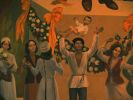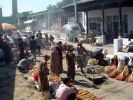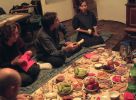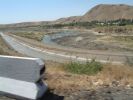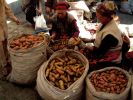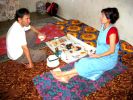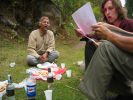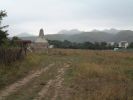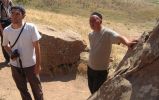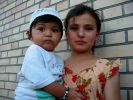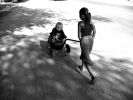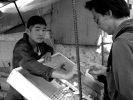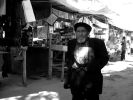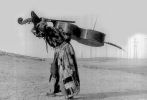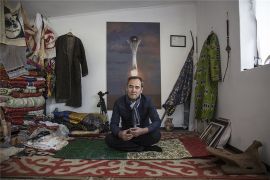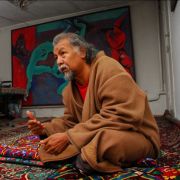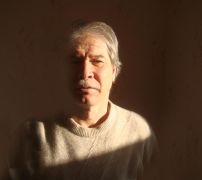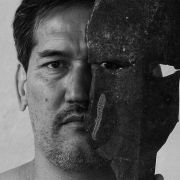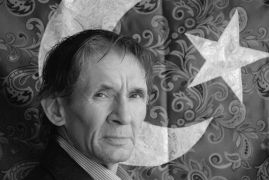The members of the Kyzyl Tractor (Red Tractor) - Said Atabekov, Smail Bayaliev, Moldakul Narymbetov, Arystanbek Shalbayev and Vitaliy Simakov - decided to set themselves the task of ‘returning to the lost roots’ of nomadic culture (Chukhovich 2011). As Kudaibergenova (2018, p. 436) notes, ‘Focusing on such discourses as nomadism, shamanism, the land and the steppe that were previously considered “backward”, “uncivilized” and certainly unwelcomed by the Soviet cultural frameworks, the new generation of postsocialist cultural producers attempted to bare these contradictions.’
(Emina Yessekeyeva and Eric Venbrux: Shamanism, Globalisation and Religion in the Contemporary Art of Said Atabekov and the Kazakh Art Collective Kyzyl Tractor)
Art collective Kyzyl Tractor was established in the early 1990s by a college professor and member of the spatial-structural composition school Vitaliy Simakov. Kyzyl Tractor has successfully developed its characteristic line of research on the mutual influence of traditional values of culture and civilization. The art group's practices are characterized as distinctive, original, authentic, and what is more important influential not only in the local context but in wider global processes that the art history goes through in modern society.
At the core of Kyzyl Tractor’s practice is a Sufi call to questioning the truth—a multilayered inquiry guided by the spirit of all things connected to nature, the cosmos and living in the present moment. This notion of time and truth is particularly apparent through the collective’s radical, open-air performances and monumental sculptures, which are unquestionably created as ephemeral acts that reject the rules of traditional institutional spaces, exhibition making, and collection building.
The name and members have not remained consistent throughout the collective’s existence but have and will continue to change. The first known title of the collective was Shymkent Trans Avant-Garde and then SAA, a verbal expression short for Salem, meaning hello or peace be upon you, or Red Tractor. Since Kyzyl Tractor’s first exhibition, was the group’s leader Moldakul Narymbetov until his passing in February 2012. Current members include Smail Bayaliyev, Said Atabekov, Vitaliy Simakov, and Arystanbek Shalbayev, who have all been the main driving force of the art group in recent years.
Constant nomadic movement, a common narrative of the 1990s, is present in most of the collective’s performances. Sacred materials such as wood and wool, felt, and other textiles found in the steppes of Kazakhstan are generally featured in Kyzyl Tractor’s performances, along with instruments like the Shan-Kobyz, dombra, and drums. The principles of the spatial-structural composition school and dervish, nomadic, and Tengri heritage have been visible in their first ten years of performative practice throughout the 1990s. Growing out of the group’s collective work, each member has simultaneously developed their own artistic practices over the years.
"Kyzyl Traktor (Red Tractor) art group and the former members of the Green Triangle group are able to navigate nationalistic narratives in their art work regardless of the Kazakh or Russian socio-linguistic divisions. Members of both groups focus on themes of ‘cosmopolitanism’ combined with the search for the national sense of the Self. One of Said Atabekov’s (Red Tractor member) works, for example, is a set of international flags sewn from the traditionally Kazakh material of korpe – large cushion-type material. In her earlier works Almagul Menlibayeva’s (former Green Triangle member) also used traditionally Kazakh or Central Asian materials (felt) and ornaments (tekemet) in her hybrid artistic production. Menlibayeva and Syrlybek Bekbotayev (current Red Tractor member) both focused on the history of Gulags in Kazakhstan and participated in the ‘Archipelago Gulag’ 2016 exhibition in Astana National Museum."
from: Diana T Kudaibergenova: Punk Shamanism, revolt and break-up of traditional linkage: The waves of cultural production in post-Soviet Kazakhstan, 2017
Moldakul Narymbetov (born 1948 in Glaba-Sai, South Kazakhstan, died 2012) lived and worked in Shymkent and Almaty, was the founder of the Kyzyl-Tractor. In 1974 he graduated from the Tashkent Art School named after Benkov and in 1990 graduated from the Faculty of graphic at the Kazakh State Pedagogical Institute named after Abay. Since 1977, Moldakul Narymbetov has taken part in more than forty international exhibitions. He opened a school of contemporary art. Among the artist's recent exhibitions, personal exhibitions at the Erarta Museum of Contemporary Art, St. Petersburg (2018), the National Museum of the Republic of Kazakhstan, Astana (2017) and the State Museum of Arts of the Republic of Kazakhstan named after Kasteev, Almaty (2012). Group exhibitions include Thinking Collection Telling Tales, New Jersey (2018), Face of the Bride at the Perm Museum of Contemporary Art PERMM, Perm (2012), Prague Quadrennial (2003), No Mad's Land at the House of World Cultures, Berlin (2002).
Said Atabekov (born 1965 in Bez Terek, Uzbekistan) is a key figure in contemporary cultural expression in Central Asia. Graduating from Shymkent Art College, where he continues to teach and organise exhibitions of upcoming artists, he was a founding member of the influential Kyzyl Tractor collective, which took advantage of Perestroika to experiment with international modernism. A witness of successive waves of social and political change in an area that is the battleground of at least four strong ideologies – nomadic pantheism, Russian, oriental and Islam, western capitalism – Atabekov explores the intersections and local impact of often-conflicting cultures, skilfully identifying and animating elements that reveal the deeper paradoxes. His video Bosphorus Prayer (2007) offers a new ritual combining Christian and Muslim gestures. His 2001 photo series The Way to Rome, ironically echoing Marco Polo’s trajectory, captures local encounters with globalisation, for example, a military tank in a field of western symbols of death, remembrance and heroin profits – poppies. In Neon Paradise (2004), a neo-shaman kneels and bows before automatic doors, both activating and responding to their opening and closing. Comic at first, it provides trenchant comment on worship, stereotypes and notions of progress and modernity. Interrogating migration and recurring cultural invasions, and revitalising the vocabulary of nomadic textiles, the shaman’s cloak Atabekov wears in performances is a patchwork of local embroideries, Soviet and American military cloth, printed slogans and oriental fabrics; his installation Flags (2006) comprises nomadic blankets decorated with the emblems of European nationalism reworked in fabrics printed with arabesques; and Made in Chinizkhan/New Uniforms for the US Army (2007) is a reversible coat with alternate army camouflage or local patterns. Said Atabekov is honoured for the poetry, depth and boldness of his artistic practice, for pushing boundaries and opening up new perspectives in a difficult transcultural context, for stimulating and fostering younger generations, and for his significant contribution to developing cultural expression across Central Asia.
Smaïl Bayaliyev (born in 1952 in the village of Iskander, a former South Kazakhstan region now belonging to Uzbekistan), graduated from Tashkent College of the Arts. Since 1981, Bayalieyv has lived and worked in the city of Shymkent, Kazakhstan, where he was a part of the first stages of the formation of the art collective Kyzyl Tractor. Starting his artistic journey through painting and collage, Bayaliyev has slowly transmitted massive public art pieces, performances and mixed-media artworks which often involve the use of kashma, a central Asian wool. Bayaliyev’s work centers around classical and regional themes, picturing still-lifes of horses and nomadic heritage that is encrypted in cultural codes of today’s society. Bayaliev has created his own unconventional way of deconstructing and revisiting these themes. His sculptures of horses are often left undone and raw, uncovering the ontological incompleteness of those animals when it comes to their roles in the past vs. modern society. In his other series, Bayeliev was inspired by suprematism, surrealism, and cubism, placing those rather western movements into an authentic context of Central Asian crafts and motifs. An active and contributing member of Kyzyl Tractor, Bayaliev’s signature exhibitions have included the seventh biennial in Tashkent, the 2003 quadriennale in Prague, ARTBAT FEST 8, and other local and international exhibitions.
Arystanbek Shalbayev (born in the Keless country of South Kazakhstan in 1959) soon after graduating from the Almaty Institute for Arts and Theater in 1984, the artist returned to Shymkent where he became a teacher at the Kasteyev school and met fellow teacher Vitaliy Simakov. Shalbayev and Simakov’s close proximity created a space for each to learn from each other and experiment with the compositional qualities of painting. Using painting, graphics, installation, video, and performance, Shalbayev’s practice is an exquisite juxtaposition of subjects and mediums. Shalbayev’s artworks display strong conceptual visual aspects which come together using a solid, almost scientific, methodology—making his process just as important as the message of his artworks. The artist is interested in absurd representations of Kazakhstan’s current-day social, cultural and economic dilemmas, as well as its history and mythological discourse. His latest series of artworks, collectively called Boomerang, reveal the self-destructive fate of Kazakhstan’s natural-resource-driven economy. Arystanbek has participated in a number of personal and group exhibitions in Kazakhstan, the UK, Czech Republic, France and Spain where his pieces have been acquired by local and public collections. Of note, Arystanbek was a part of the show Nomads, a collective exhibition of artists from Kazakhstan in Moscow; Life is a Legend, a show of contemporary Kazakhstan art in Strasbourg, France; and the ArtBat Festival in Almaty, Kazakhstan.
Vitaliy Simakov was born in 1954 in the Republic of Bashkortostan. In 1983, he graduated from the National Institute of the Arts in Ufa with a bachelor’s degree in fine arts. Soon after, the artist moved to Shymkent and taught a class on spatial-structural composition which resulted in the formation of Kyzyl Tractor. Smakov became a pivotal critical influence in the academic understanding of the Kyzyl Tractor’s artwork as well as an active participant in their performances in the 1990’s. Later, Simakov concentrated his attention on teaching and slowly passed the leadership of the art collective to Moldakul Narymbetov. The artists remained a collaborator and close friend to the artist group until the death of Moldakul in 2012. In the past 35 years, Simakov has lived and worked in Shymkent where he still teaches part-time and has up to 50 graduate students per year.
